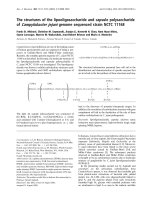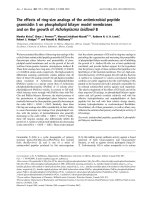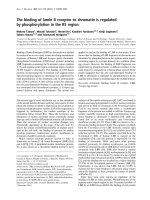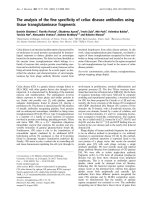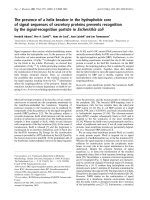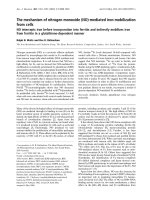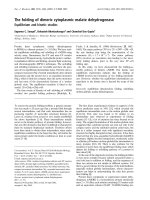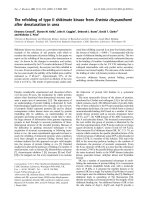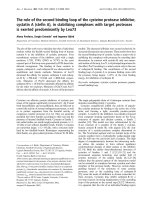Báo cáo y học: "The angiogenesis inhibitor protease-activated kringles 1–5 reduces the severity of murine collagen-induced arthritis" ppsx
Bạn đang xem bản rút gọn của tài liệu. Xem và tải ngay bản đầy đủ của tài liệu tại đây (417.78 KB, 8 trang )
R32
Introduction
Inflammatory joint diseases such as rheumatoid arthritis
(RA) are a major cause of disability, and are frequently
associated with increased morbidity and mortality. A hall-
mark feature of RA is chronic inflammation and hyperpla-
sia of the synovial lining of joints. The expanding synovial
tissue invades and subsequently destroys the underlying
cartilage and bone. Increased cellularity is also observed
within both the synovial fluid and synovial membrane,
which is due to recruitment and retention of cells from
the blood, including macrophages, T cells and dendritic
cells [1].
The enlarged synovium imposes an increased demand for
nutrients and oxygen. A hallmark of RA is thus an
increased rate of formation of new blood vessels (‘angio-
genesis’) [2–4]. Many proangiogenic mediators are
expressed in RA, including vascular endothelial growth
factor (VEGF). VEGF is expressed in RA synovium [5–7],
and levels of VEGF are upregulated in the serum of RA
patients [8,9]. These observations suggest that angiogen-
esis is an important event during the development of RA.
Paradoxically, however, in spite of the increased rate of
endothelial proliferation and expression of molecules such
as VEGF, angiogenesis may not keep pace with synovial
hyperplasia, resulting in areas of hypoxia [10]. This hypoxic
state stimulates the production of angiogenic factors and
further perpetuates new blood vessel formation. Targeting
the vasculature in RA is thus a potential therapeutic
approach in RA [11,12].
CIA = collagen-induced arthritis; K1–5 = protease-activated kringles 1–5; PBS = phosphate-buffered saline; RA = rheumatoid arthritis; TNF =
tumour necrosis factor; VEGF = vascular endothelial growth factor.
Arthritis Research and Therapy Vol 5 No 1 Sumariwalla et al.
Research article
The angiogenesis inhibitor protease-activated kringles 1–5
reduces the severity of murine collagen-induced arthritis
Percy F Sumariwalla
1
, Yihai Cao
2
, Hua-Lin Wu
3
, Marc Feldmann
1
and Ewa M Paleolog
1
1
Kennedy Institute of Rheumatology Division, Faculty of Medicine, Imperial College of Science, Technology and Medicine, London, UK
2
Laboratory of Angiogenesis Research, Microbiology and Tumor Biology Center, Karolinska Institute, Stockholm, Sweden
3
Department of Biochemistry, National Cheng Kung University Medical College, Taiwan, Republic of China
Corresponding author: Dr Ewa Paleolog (e-mail: )
Received: 10 July 2002 Revisions received: 27 September 2002 Accepted: 2 October 2002 Published: 31 October 2002
Arthritis Res Ther 2003, 5:R32-R39 (DOI 10.1186/ar608)
© 2003 Sumariwalla et al., licensee BioMed Central Ltd (Print ISSN 1478-6354; Online ISSN 1478-6362). This is an Open Access article:
verbatim copying and redistribution of this article are permitted in all media for any non-commercial purpose, provided this notice is preserved along
with the article's original URL.
Abstract
During rheumatoid arthritis there is enlargement and increased
cellularity of the synovial lining of joints, before invasion by the
synovium of the underlying cartilage and bone. This increased
tissue mass requires a network of blood vessels to supply
nutrients and oxygen. Disruption of synovial angiogenesis is thus
a desirable aim of antiarthritic therapies. Protease-activated
kringles 1–5 (K1–5) is an angiogenesis inhibitor related to
angiostatin. In common with angiostatin, K1–5 contains the first
four kringle domains of plasminogen, but also encompasses the
kringle 5 domain, which confers enhanced antiangiogenic
activity when compared with angiostatin. The purpose of the
present study was to assess the effect on murine arthritis of
K1–5. Arthritis was induced in DBA/1 mice by a single injection
of bovine collagen. Treatment with K1–5 was commenced on
the day of arthritis onset and continued for 10 days, until the
end of the experiment. Daily intraperitoneal administration of
K1–5 (2 mg/kg body weight) significantly reduced both paw
swelling and clinical score (a composite index of the number of
arthritic limbs and the severity of disease). The clinical efficacy
of this treatment was reflected by a reduction in joint
inflammation and destruction, as assessed histologically. These
data suggest that antiangiogenic therapies, which block
formation of new blood vessels and hence reduce synovial
expansion, might be effective in treating rheumatoid arthritis.
Keywords: angiogenesis, arthritis
Open Access
Available online />R33
Several broadly acting angiogenesis inhibitors, such as
paclitaxel, TNP-470 and thalidomide, have been shown to
inhibit pannus formation and neovascularization in animal
models of arthritis [13–18]. Recently, more specific
antiangiogenic approaches have been employed. For
example, our group reported that a soluble form of the Flt-
1 VEGF receptor significantly reduced disease severity
and joint destruction in murine collagen-induced arthritis
(CIA) [19]. The effectiveness of VEGF blockade in CIA
was also shown in further studies using anti-VEGF poly-
clonal antibodies [20,21]. These examples support the
concept that antiangiogenic therapies may be a potentially
useful tool in the treatment of arthritis.
In addition to blocking the activity of proangiogenic mole-
cules such as VEGF, an alternative approach would be to
utilize known inhibitors of angiogenesis [22]. One such
potent angiogenesis inhibitor is angiostatin, which is gen-
erated as a result of proteolytic cleavage of plasminogen
and comprises the first four triple loop disulphide-linked
structures of plasminogen, termed kringle domains
[23,24]. Characterization of the inhibitory activity of kringle
(K) fragments of angiostatin demonstrated that K1, K2 and
K3, but not K4, inhibited endothelial cell proliferation,
whereas a structure combining K1–3 was more effective
than K1–4 (equivalent to angiostatin) [25]. A subsequent
study revealed that the K5 proteolytic fragment of human
plasminogen is an even more potent inhibitor of endothe-
lial proliferation [26]. Urokinase-activated plasmin can also
convert plasminogen into a molecule containing the intact
K1–4 and most of the K5 domains, termed K1–5. That
angiogenesis inhibitor inhibited endothelial cell prolifera-
tion more effectively than did angiostatin. Moreover, K1–5
treatment suppressed tumour growth and neovasculariza-
tion in mice carrying a primary fibrosarcoma [27].
The effectiveness of K1–5 treatment in the mouse tumour
model prompted us to examine the effects of this inhibitor
in murine CIA, which has several similarities with RA,
including synovitis, pannus formation, erosion of cartilage
and bone, fibrosis and joint rigidity. The relevance of this
model has been demonstrated using anti-tumour necrosis
factor (TNF)-α antibody, which was first used to amelio-
rate CIA [28], and was subsequently proven to be clini-
cally effective for the treatment of human RA [29]. In the
present study we observed that systemic administration of
K1–5 markedly reduced clinical and pathological features
of established CIA. This was accompanied by a significant
reduction in the histological features of disease. These
data indicate that antiangiogenic therapies could have
potential applications in the management of RA.
Materials and method
Induction and assessment of arthritis
Ten-week-old, inbred, male DBA/1 (H-2
q
) mice (Harlan
UK Limited, Oxon, UK) received a single intradermal
injection of 100 µl bovine type II collagen [30] emulsified
in complete Freund’s adjuvant (Difco, Detroit, MI, USA)
at the base of the tail. The first clinical signs of arthritis,
as assessed by oedema and/or erythema involving any of
the paws, appeared between days 14 and 28 after
immunization, with a mean onset of arthritis at day 21
after immunization.
Mice were monitored daily and each limb was given a clin-
ical score as follows: 0, normal paws and no clinical fea-
tures of inflammation; 1, slight oedema or erythema; 1.5,
oedema and erythema involving at least some digits; 2,
frank oedema/erythema involving the entire paw; and 2.5,
pronounced oedema and erythema leading to incapaci-
tated limb mobility. Each limb was graded in this manner,
giving a maximum possible score of 10 per mouse. All
hind paws were measured daily to record the degree of
paw thickness, using a fine engineer’s calliper (least count
0.1 mm; Röhm GB Ltd, Kingston-Upon-Thames, UK). Mice
were humanely killed on day 10 of disease. Data are
expressed as mean (± SEM) clinical score or paw thick-
ness. Alternatively, data are expressed as the increase in
clinical score or paw thickness from day 1 of arthritis.
Preparation and
in vivo
administration of
protease-activated kringles 1–5
K1–5 was prepared by urokinase-activated plasmin-medi-
ated digestion of amino-terminal Glu
1
-plasminogen, as
previously described [27]. The purified K1–5 was ana-
lyzed using amino-terminal and carboxyl-terminal sequenc-
ing, and stored diluted in phosphate-buffered saline (PBS)
at –80°C before use.
In order to assess the effect of K1–5 on established CIA,
treatment was commenced from the first day of the onset
of the clinical symptoms of arthritis, which was considered
to be the day when the first visible signs of erythema
and/or oedema were observed in any of the limbs. Mice
were randomly selected and assigned to one of the follow-
ing groups: no treatment, vehicle (equal volume of PBS,
pH 7.2), or K1–5. The route of delivery was intraperitoneal
administration, at doses of either 0.2 mg/kg body weight
or 2 mg/kg body weight. Treatments were given daily for a
period of 10 days. Assessments of clinical score and paw
thickness were performed by an observer who was
unaware of the treatment group to which the animals had
been assigned.
Histological assessment
Hind feet were removed after death and fixed using 4.5%
buffered formalin. One week later, hind feet were decalci-
fied in buffered formalin containing 5.5% EDTA. Upon
decalcification, paws were embedded in paraffin wax
blocks, sectioned, and stained with haematoxylin and
eosin for microscopic evaluation, which was performed by
an observer who was blinded to the treatments received.
Arthritis Research and Therapy Vol 5 No 1 Sumariwalla et al.
R34
Each section was screened for changes to the joint archi-
tecture and every joint was scored as follows: normal, mild
(minimal synovitis, some cartilage loss, shrinkage in the
size of cartilage chondrocytes with denucleation, and
bone erosions limited to discrete foci), moderate (more
extensive synovial hyperplasia, destruction of large seg-
ments of the cartilage and considerable bone erosions
caused by an invasive pannus front) and severe (complete
destruction of the joint architecture).
Measurement of antibovine collagen type II IgG
Blood samples were collected from mice on day 10 of
arthritis by exsanguination following terminal cardiac punc-
ture. The blood was allowed to clot at room temperature
for 1 hour followed by incubation at 4°C overnight to sepa-
rate the serum, which was aliquoted and stored at –20°C.
To assay the serum levels of total antibovine collagen type
II IgG, microtitre plates were coated with 2 µg/ml of puri-
fied bovine collagen type II in Tris-buffered saline
overnight at 4°C. The plates were blocked with 2% bovine
serum albumin in PBS and incubated with serum at 4°C
overnight. Bound IgG was detected with alkaline phos-
phatase conjugated goat antimouse IgG (Sigma, Poole,
Dorset, UK) followed by p-nitrophenyl phosphate.
Absorbance was determined at 405 nm. To quantify anti-
bovine collagen IgG, pooled serum from mice killed on day
10 of arthritis (n = 6; arthritis clinical score 10) was
assigned an arbitrary value of 100 units/ml.
Statistical analyses
Data were analyzed using the Graph Pad Prism software
package (Graph Pad Software, San Diego, CA, USA).
Two-way analysis of variance was used to compare effect
of different treatments on the clinical scores and paw
thickness. One-way analysis of variance with Newman–
Keul post-test for multiple comparisons was used to
compare serum anticollagen IgG levels. The statistical sig-
nificance of histology data was evaluated by comparing
the number of sections that were either normal, or exhib-
ited mild, moderate or severe changes, using χ
2
test for
trends. Data from individual experiments were analyzed
separately, although the same trend was seen in all of
three experiments.
Results
Protease-activated kringles 1–5 significantly reduces
disease severity in murine collagen-induced arthritis
To determine the effect of K1–5 on CIA, treatment was
commenced on the first day of arthritis. Animals were
treated with K1–5 and compared with those administered
PBS as the vehicle control. A control group of animals
was left untreated.
In a total of three experiments, intraperitoneal administra-
tion of K1–5 at a dose of 2 mg/kg (40 µg per mouse)
every day until day 10 markedly reduced the severity of
CIA. A typical experiment is illustrated in Table 1, which
shows the absolute values for the clinical scores (a com-
posite index of disease severity and the number of limbs
affected) and the paw thickness. In order to normalize the
data, these parameters were also expressed as change
from day 1 of disease (Figs 1 and 2). For example,
untreated mice exhibited a mean increase in paw thick-
ness by day 4 of disease of 0.42 ± 0.09 mm, as compared
to 0.01 ± 0.06 mm for animals that received K1–5. By day
10 of arthritis, untreated or vehicle-treated mice exhibited
mean paw swelling of 0.49 ± 0.11 mm and
0.50 ± 0.09 mm, respectively, as compared with
0.26 ± 0.13 mm for animals receiving daily intraperitoneal
administration of 2 mg/kg K1–5 (P < 0.001, versus
untreated or vehicle-treated animals). Similarly, the mean
increase in clinical score by day 4 of disease was
2.50 ± 0.54 for untreated mice, but only 0.25 ± 0.63 for
mice treated with K1–5. On day 10 the mean increase in
clinical score was 3.00 ± 0.55 and 4.00 ± 1.09 for
untreated and vehicle-treated mice, but only 1.30 ± 0.78
for mice treated with K1–5 (P < 0.001, versus untreated
or vehicle-treated animals). The effect of K1–5 was dose
dependent, in that 0.2 mg/kg (4 µg per mouse) every day
until day 10 was without significant effect on CIA progres-
sion (increase in clinical score on day 10 of arthritis
4.00 ± 1.06 [Fig. 1], paw swelling on day 10 of arthritis
0.49 ± 0.10 mm [Fig. 2]). Comparable data were obtained
in all three experiments.
In order to further assess the effect of in vivo K1–5 treat-
ment, we measured serum levels of antibovine type II col-
lagen antibodies on day 10 of arthritis. Administration of
K1–5 did not affect the total serum levels of antibovine
collagen IgG (Fig. 3).
Protease-activated kringles 1–5 decreases joint
inflammation and destruction in collagen-induced
arthritis
In order to determine the effect of treatment with K1–5 on
synovial inflammation and bone destruction in CIA, sec-
tions from untreated animals, and animals treated with
vehicle and K1–5 (sacrificed on day 10 of arthritis) were
graded in a blinded manner. The percentages of joints that
exhibited normal, mild, moderate or severe changes in
bone/cartilage and synovitis were calculated.
A representative experiment is illustrated in Table 2 and
Fig. 4. Each joint (distal phalanx joint, proximal phalanx joint,
first metatarsal joint and tarsus) was first assessed sepa-
rately (Table 2). The most apparent differences were
observed in the distal phalanx and proximal phalanx joints. In
animals treated with 2 mg/kg K1–5 there were fewer
severely affected joints and an increase in the number of
joints in which the cartilage and bone architecture at joint
interfaces appeared normal relative to control animals. For
Available online />R35
Table 1
Effect of protease-activated kringles 1–5 treatment on clinical score and paw thickness
Day of arthritis Untreated Vehicle K1–5 0.2 mg/kg K1–5 2 mg/kg
Clinical score
1 2.38 ± 0.26** 2.22 ± 0.28** 2.50 ± 0.19** 2.57 ± 0.20
2 4.08 ± 0.54** 3.36 ± 0.43** 3.64 ± 0.40** 2.33 ± 0.17
3 4.71 ± 0.47** 3.93 ± 0.48** 4.29 ± 0.52** 2.14 ± 0.18
4 4.93 ± 0.69** 4.11 ± 0.52** 4.93 ± 0.44** 2.75 ± 0.75
5 5.29 ± 0.62** 4.44 ± 0.54** 5.19 ± 0.58** 3.25 ± 0.51
6 5.00 ± 0.45** 4.89 ± 0.54** 5.70 ± 0.44** 3.75 ± 0.51
7 5.57 ± 0.47** 5.33 ± 0.82** 5.67 ± 1.17** 4.33 ± 0.38
8 5.63 ± 0.45** 5.00 ± 0.65** 5.56 ± 0.95** 3.33 ± 0.38
9 5.31 ± 0.59** 6.50 ± 0.79** 5.75 ± 0.85** 4.00 ± 0.64
10 5.60 ± 0.68** 5.81 ± 0.98** 6.50 ± 1.03** 3.90 ± 0.91
Paw thickness (mm)
1 1.93 ± 0.04** 1.88 ± 0.06* 1.94 ± 0.06** 1.91 ± 0.04
2 2.20 ± 0.11** 2.05 ± 0.08* 2.11 ± 0.11** 1.96 ± 0.08
3 2.25 ± 0.11** 2.11 ± 0.11* 2.19 ± 0.10** 1.91 ± 0.09
4 2.36 ± 0.13** 2.19 ± 0.10* 2.30 ± 0.13** 1.92 ± 0.10
5 2.34 ± 0.14** 2.22 ± 0.12* 2.33 ± 0.10** 2.14 ± 0.13
6 2.22 ± 0.14** 2.25 ± 0.12* 2.47 ± 0.12** 2.16 ± 0.12
7 2.49 ± 0.11** 2.23 ± 0.14* 2.50 ± 0.12** 2.21 ± 0.12
8 2.43 ± 0.12** 2.33 ± 0.12* 2.41 ± 0.11** 2.20 ± 0.12
9 2.37 ± 0.12** 2.40 ± 0.09* 2.41 ± 0.10** 2.20 ± 0.11
10 2.45 ± 0.15** 2.40 ± 0.09* 2.42 ± 0.11** 2.19 ± 0.16
From the day of arthritis onset, mice were treated intraperitoneally each day with either vehicle (phosphate buffered saline [PBS]), protease-
activated kringles 1–5 (K1–5) at a dose of either 0.2 mg/kg or 2 mg/kg, or were left untreated. The absolute values for clinical scores and paw
thickness are shown. Data were analyzed by two-way analysis of variance: *P < 0.01, **P < 0.001, versus mice treated with 2 mg/kg K1–5; all
other values P > 0.10. For numbers of mice in each group, see the legends to Figs 1 and 2.
Figure 1
Treatment with protease-activated kringles 1–5 (K1–5) significantly
reduces the severity of collagen-induced arthritis. From the day of
arthritis onset, mice were treated intraperitoneally each day with (᭡)
vehicle (n = 9), (᭺) K1–5 at a dose of 0.2 mg/kg (n = 8) or (᭹) K1–5
at a dose of 2 mg/kg (n = 8), or () were left untreated (n = 8). The
clinical score is expressed as change from day 1 (mean ± SEM). Data
were analyzed by two-way analysis of variance: P < 0.001 for mice
treated with 2 mg/kg K1–5, versus untreated mice, and mice treated
with vehicle or 0.2 mg/kg K1–5; P > 0.10 for untreated and vehicle-
treated mice, versus mice treated with 0.2 mg/kg K1–5.
1 2 3 4 5 6 7 8 910
-1
0
1
2
3
4
5
6
Day of arthritis
Clinical score (change from day 1)
Figure 2
Treatment with protease-activated kringles 1–5 (K1–5) significantly
reduces paw swelling in collagen-induced arthritis. From the day of
arthritis onset, mice were treated intraperitoneally each day with (᭡)
vehicle (n = 9), (᭺) K1–5 at a dose of 0.2 mg/kg (n = 8) or (᭹) K1–5
at a dose of 2 mg/kg (n = 8), or () were left untreated (n = 8). Paw
thickness is expressed as change from day 1 (mean ± SEM). Data
were analyzed by two-way analysis of variance: P < 0.001 for mice
treated with 2 mg/kg K1–5, versus untreated mice, and mice treated
with vehicle or 0.2 mg/kg K1–5; P > 0.10 for untreated and vehicle-
treated mice, versus mice treated with 0.2 mg/kg K1–5.
1 2 3 4 5 6 7 8 910
0.0
0
.1
0
.2
0
.3
0
.4
0
.5
0
.6
0.7
Day of arthritis
Paw thickness (change from day 1, mm)
the first metatarsal and tarsal joints, the differences were
less pronounced and did not achieve statistical significance.
Examples of the histological appearance of joints following
different treatments are shown in Fig. 5. The joints in
untreated animals, and animals treated with vehicle and
0.2 mg/kg K1–5 exhibited a thickened synovium with a
large number of infiltrating cells, together with invasion and
erosion of bone by the synovium. Joint space narrowing
and necrosis are evident. In contrast, joints from animals
treated with K1–5 at 2 mg/kg were relatively normal in
appearance, with well preserved joint architecture.
Figure 4 illustrates the effect of K1–5 on the percentage of
joints exhibiting no change, or mild, moderate or severe
destruction and inflammation. In mice treated with 2 mg/kg
K1–5 there was a reduction in the percentage of severely
affected joints (34%) relative to untreated (52%) and PBS-
treated (47%) animals. There was also an increase in the
number of joints in which the cartilage and bone architec-
ture at joint interfaces appeared normal. For example, 18
out of 47 (38%) examined joint sections from mice treated
with K1–5 exhibited no destruction of bone or cartilage.
This contrasted with only 10 out of 50 (20%) normal paws
from untreated animals (P < 0.05, versus K1–5) and 7 out
of 55 (13%) paws from PBS-treated animals (P < 0.05).
As expected, given the lack of clinical efficacy, intraperi-
toneal treatment with the lower dose of 0.2 mg/kg K1–5
was without significant effect on joint destruction (62%
severely affected joints, 7% normal joints).
Discussion
New blood vessel formation serves to supply oxygen and
nutrients to the developing synovium in RA. Targeting the
angiogenic process in RA should thus potentially reduce
joint inflammation and synovial hyperplasia. Animal
models have been extensively used to evaluate the thera-
peutic potential of antiangiogenic approaches. Broadly
acting angiogenesis inhibitors have been described to
reduce disease in several rodent models. For example,
AGM-1470 (TNP-470), a synthetic derivative of fumag-
illin, reduced rat CIA as well as the severity of sponta-
neous polyarthritis in the KRN/NOD transgenic mouse
[13–15,18]. Recently, studies from our own group using
the murine CIA model showed that soluble VEGF recep-
tor 1 reduced disease severity when injected intraperi-
Arthritis Research and Therapy Vol 5 No 1 Sumariwalla et al.
R36
Figure 3
Protease-activated kringles 1–5 (K1–5) does not significantly affect
serum anticollagen IgG. From the day of arthritis onset, mice were
treated with (᭡) vehicle (phosphate-buffered saline [PBS]; n = 15),
(᭺) K1–5 at a dose of 0.2 mg/kg (n = 8) or (᭹) K1–5 at a dose of
2 mg/kg (n = 13), or () were left untreated (n = 14). Serum
anticollagen IgG was measured on day 10 of arthritis and is expressed
as arbitrary units/ml, with reference to pooled serum from mice killed
on day 10 of arthritis. Data were analyzed by one-way analysis of
variance with Newman–Keul post-test for multiple comparisons:
P > 0.10 for all comparisons.
10
100
1000
10000
Untreated PBS
(vehicle)
K1-5
(0.2mg/kg)
K1-5
(2mg/kg)
Treatment groups
Total serum anti-collagen IgG
Figure 4
Administration of protease-activated kringles 1–5 (K1–5) reduces joint
destruction in collagen-induced arthritis. From the day of arthritis onset,
mice were treated intraperitoneally each day with vehicle (phosphate-
buffered saline [PBS]; n = 15), K1–5 at a dose of 0.2 mg/kg (n = 8) or
K1–5 at a dose of 2 mg/kg (n = 13), or were left untreated (n = 8). On
day 10 of arthritis, paws were fixed and stained with haematoxylin and
eosin for histological assessment. Data are expressed as percentages
of joints exhibiting normal, mild, moderate and severe inflammation and
bone/cartilage degradation. Data were analyzed using χ
2
test for trend:
P < 0.001 for mice treated with 2 mg/kg K1–5, versus untreated mice
and mice treated with 0.2 mg/kg K1–5; P < 0.01 for mice treated with
2 mg/kg K1–5, versus vehicle-treated mice.
0
10
20
30
40
50
60
70
80
Normal
Mild
Moderate
Severe
Untreated PBS
(vehicle)
K1-5
(0.2mg/kg)
K1-5
(2mg/kg)
Treatment groups
% Joints affected
toneally every day for the first 5 days after disease onset
[19]. Similar results were obtained using anti-VEGF anti-
bodies [20,21]. More recently, an antibody against VEGF
receptor 1 suppressed angiogenesis and joint destruc-
tion in CIA when given before disease onset [31]. Inter-
estingly, anti-VEGF receptor 1 antibody reduced
mobilization of bone marrow derived myeloid progenitors
into the peripheral blood, suggesting that part of the
mechanism of action in that study was impairment in leu-
cocyte infiltration.
These observations demonstrate that inhibition of angio-
genesis suppresses arthritis in animal models. In terms of
the effect on CIA of endogenously generated angiogenic
inhibitors, a very recent report indicated that angiostatin
can delay the onset of CIA in DBA/1 mice [32]. In that
study, fibroblasts, transduced with angiostatin-expressing
retroviral vectors, were transplanted into the knee before
the onset of arthritis or macroscopic signs of arthritis.
Angiostatin was found to reduce pannus formation and
angiogenesis. Other studies have reported that endo-
statin, a 20 kDa fragment of collagen XVIII, can also
reduce disease. Using a model in which human RA tissue
is grafted into severe combined immunodeficiency mice, it
was shown that intrasynovial injection of human recombi-
nant endostatin reduced both the volume of the grafted
synovium and the number of vessels [33]. Similarly, endo-
statin-expressing lentivirus injected directly into the joints
of human TNF transgenic mice before the onset of
disease reduced synovial blood vessel density and arthritis
severity [34].
In the present study we examined the effect on CIA of
K1–5 – an angiogenesis inhibitor that is structurally
related to angiostatin. In common with angiostatin, K1–5
contains four of the disulphide-linked kringle domains of
plasminogen, but it also includes most of K5 – a potent
inhibitor of endothelial cell proliferation [26,27]. We chose
to administer K1–5 after the onset of macroscopic signs
of arthritis because we believe that this therapeutic
approach is more relevant to the treatment of RA than the
preventive regimen utilized in other studies [32,34]. The
relevance of this methodology has been demonstrated
using anti-TNF-α antibody, which was first shown to ame-
liorate CIA [28], and was then proven to be clinically effec-
tive for the treatment of human RA [29].
We report here that intraperitoneal administration of K1–5
significantly reduces disease severity in an acute model of
established arthritis. This dose-dependent amelioration in
the severity of disease was observed for both the clinical
score (an index of disease severity and the number of
affected paws) and for paw swelling. Histological examina-
tion of all joints from the hind feet of mice treated with
K1–5 revealed a significant degree of joint protection
when compared with vehicle-treated or with untreated
mice groups. A comparable amelioration of CIA (reduced
footpad swelling, clinical score, bone/cartilage destruction
Available online />R37
Table 2
Effect of protease-activated kringles 1–5 administration on joint destruction
Normal Mild Moderate Severe
Distal phalanx joints
Untreated* 0 (0%) 3 (60%) 2 (40%) 0 (0%)
Vehicle 3 (37%) 0 (0%) 4 (50%) 1 (13%)
K1–5 0.2 mg/kg ** 0 (0%) 2 (33%) 1 (17%) 3 (50%)
K1–5 2 mg/kg 6 (86%) 0 (0%) 1 (14%) 0 (0%)
Proximal phalanx joints
Untreated 4 (25%) 2 (12%) 2 (12%) 8 (50%)
Vehicle* 1 (6%) 4 (27%) 0 (0%) 10 (67%)
K1–5 0.2 mg/kg** 1 (8%) 1 (8%) 0 (0%) 10 (83%)
K1–5 2 mg/kg 7 (54%) 2 (15%) 1 (8%) 3 (23%)
First metatarsal joints
Untreated 4 (25%) 1 (6%) 1 (6%) 10 (63%)
Vehicle 1 (5%) 5 (28%) 3 (17%) 9 (50%)
K1–5 0.2 mg/kg 1 (7%) 3 (20%) 2 (13%) 9 (60%)
K1–5 2mg/kg 3 (20%) 1 (7%) 3 (20%) 8 (53%)
Tarsal joints
Untreated 2 (15%) 1 (7%) 2 (15%) 8 (62%)
Vehicle 2 (14%) 3 (21%) 3 (21%) 6 (43%)
K1–5 0.2 mg/kg 1 (8%) 0 (0%) 5 (42%) 6 (50%)
K1–5 2 mg/kg 2 (17%) 1 (8%) 4 (33%) 5 (42%)
Mice were treated with vehicle (phosphate-buffered saline [PBS]) or protease-activated kringles 1–5 (K1–5) at a dose of either 0.2 mg/kg or
2 mg/kg, or were left untreated. On day 10 of arthritis, paws were fixed and stained with haematoxylin and eosin for histological assessment of
distal phalanx, proximal phalanx, first metatarsal and tarsal joints. Data were analyzed using χ
2
test for trend: *P < 0.05, **P < 0.01, versus mice
treated with 2 mg/kg K1–5.
and synovitis) was observed when K1–5 was adminis-
tered subcutaneously at a daily dose of 2.5 mg/kg (data
not shown). We propose that K1–5 mediates its actions in
CIA by preventing the formation of new vessels in the pro-
liferating synovium of the inflamed joints. This is supported
by data showing that K1–5 significantly reduced fibroblast
growth factor-2-induced neovascularization in the mouse
corneal micropocket assay and reduced angiogenesis in
chicken embryos. Moreover, K1–5 significantly sup-
pressed tumour growth and microvessel density of a
murine fibrosarcoma [27]. We have also observed inhibi-
tion of fibroblast growth factor-2-driven proliferation of the
murine endothelial cell line Py4-1 (data not shown).
The mechanism of action of K1–5 is at present unknown,
but it may be analogous to the proposed modes of action
of angiostatin. Angiostatin has been shown to induce
apoptosis in endothelial cells selectively [35]. A subse-
quent study showed that angiostatin blocks invasion of
tissue plasminogen activator-producing endothelial and
melanoma cells [36]. In another study, the α/β subunits of
ATP synthase were identified as an angiostatin binding
site on human umbilical vein endothelial cells. It was pro-
posed that the binding of angiostatin to plasma mem-
brane-localized ATP synthase may disrupt production of
ATP and render endothelial cells more vulnerable to irre-
versible cell damage [37]. Angiostatin has also been
found to inhibit migration of monocytes and neutrophils in
response to the chemokines interleukin-8, macrophage
inflammatory protein-2 and growth-regulating oncogene α,
with both the K1–4 and K1–3 forms being active. Angio-
statin also inhibited chemokine-induced angiogenesis in
vivo, in parallel with a reduction in the number of recruited
leucocytes [38]. Thus, in addition to the antiangiogenic
activity of angiostatin and K1–5, it is possible that these
molecules might exert anti-inflammatory effects as well.
Recently, bovine arterial endothelial cells were shown to
adhere to angiostatin in an α
v
β
3
integrin dependent
manner. Of particular relevance to the present study, K1–3
and K1–5, but not plasminogen, were shown to bind to
α
v
β
3
integrin [39]. Thus, K1–5 might reduce angiogenesis
by interfering with α
v
β
3
-mediated signal transduction.
Conclusion
K1–5 appears to be an effective therapeutic agent in
murine CIA, most probably due to reduced synovial infiltra-
tion and inflammation subsequent to decreased synovial
vascularity. Although we were unable to show complete
reversal of the clinical signs of arthritis, a very significant
degree of joint protection was observed in mice treated
with K1–5. In RA, it has been suggested that established
therapies such as TNF-α blockade might predispose to
infections. This is not likely, in theory at least, to be a side
effect of antiangiogenic treatments, and hence combina-
tion of TNF-α inhibition and angiogenesis blockade may be
beneficial, without augmenting potential adverse effects.
Acknowledgements
The Kennedy Institute of Rheumatology Division receives a core grant
from ARC. The authors are grateful to Paul Warden and the staff of the
Biological Services Unit for care and maintenance of the animals, and to
Mr P Connolly for histology. All research was performed in accordance
with the guidelines of the Kennedy Institute of Rheumatology Ethical
Review Process Committee and the Home Office Guidance on the Oper-
ation of the Animals (Scientific Procedures) Act 1986 (PPL70/4158).
References
1. Feldmann M, Brennan FM, Maini RN: Rheumatoid arthritis. Cell
1996, 85:307-310.
2. Paleolog EM: Angiogenesis: a critical process in the pathogen-
esis of RA: a role for VEGF? Br J Rheumatol 1996, 35:917-919.
3. Koch AE: Review: angiogenesis: implications for rheumatoid
arthritis. Arthritis Rheum 1998, 41:951-962.
4. Paleolog EM, Fava RA: Angiogenesis in rheumatoid arthritis:
implications for future therapeutic strategies. Springer Semin
Immunopathol 1998, 20:73-94.
Arthritis Research and Therapy Vol 5 No 1 Sumariwalla et al.
R38
Figure 5
Histological appearance of joints after administration of protease-
activated kringles 1–5 (K1–5). Haematoxylin and eosin stained
sections of distal phalanx, proximal phalanx, first metatarsal and tarsus
joints from (a) untreated mice, (b) vehicle (phosphate buffered saline
[PBS])-treated mice, and animals receiving K1–5 at a daily
intraperitoneal dose of either (c) 0.2 mg/kg or (d) 2 mg/kg. All sections
were obtained on day 10 of arthritis. Magnification ×40. s, synovium; e,
bone erosions.
(a) Untreated (b) PBS (vehicle) (c) K1-5 (0.2mg/kg) (d) K1-5 (2mg/kg)
Distal phalanx
Proximal phalanx
First metatarsal
Tarsus
s
e
s
e
s
e
s
e
s
e
s
e
s
e
s
e
e
s
s
e
s
e
s
e
5. Fava RA, Olsen NJ, Spencer-Green G, Yeo KT, Yeo TK, Berse B,
Jackman RW, Senger DR, Dvorak HF, Brown LF: Vascular per-
meability factor/endothelial growth factor (VPF/VEGF): accu-
mulation and expression in human synovial fluids and
rheumatoid synovial tissue. J Exp Med 1994, 180:341-346.
6. Koch AE, Harlow LA, Haines GK, Amento EP, Unemori EN, Wong
WL, Pope RM, Ferrara N: Vascular endothelial growth factor. A
cytokine modulating endothelial function in rheumatoid arthri-
tis. J Immunol 1994, 152:4149-4156.
7. Nagashima M, Yoshino S, Ishiwata T, Asano G: Role of vascular
endothelial growth factor in angiogenesis of rheumatoid
arthritis. J Rheumatol 1995, 22:1624-1630.
8. Paleolog EM, Young S, Stark AC, McCloskey RV, Feldmann M,
Maini RN: Modulation of angiogenic vascular endothelial
growth factor by tumor necrosis factor alpha and interleukin-1
in rheumatoid arthritis. Arthritis Rheum 1998, 41:1258-1265.
9. Ballara SC, Taylor PC, Reusch P, Marmé D, Feldmann M, Maini
RN, Paleolog EM: Raised serum vascular endothelial growth
factor levels are associated with destructive change in inflam-
matory arthritis. Arthritis Rheum 2001, 44:2055-2064.
10. Blake DR, Merry P, Unsworth J, Kidd BL, Outhwaite JM, Ballard R,
Morris CJ, Gray L, Lunec J: Hypoxic-reperfusion injury in the
inflamed human joint. Lancet 1989, 1:289-293.
11. Paleolog EM, Miotla JM: Angiogenesis in arthritis: role in
disease pathogenesis and as a potential therapeutic target.
Angiogenesis 1998, 2:295-307.
12. Ballara SC, Miotla JM, Paleolog EM: New vessels, new
approaches: angiogenesis as a therapeutic target in muscu-
loskeletal disorders. Int J Exp Pathol 1999, 80:235-250.
13. Peacock DJ, Banquerigo ML, Brahn E: Angiogenesis inhibition
suppresses collagen arthritis. J Exp Med 1992, 175:1135-
1138.
14. Oliver SJ, Banquerigo ML, Brahn E: Suppression of collagen-
induced arthritis using an angiogenesis inhibitor, AGM-1470,
and a microtubule stabilizer, taxol. Cell Immunol 1994, 157:
291-299.
15. Oliver SJ, Cheng TP, Banquerigo ML, Brahn E: Suppression of
collagen-induced arthritis by an angiogenesis inhibitor, AGM-
1470, in combination with cyclosporin: reduction of vascular
endothelial growth factor (VEGF). Cell Immunol 1995, 166:
196-206.
16. Arsenault AL, Lhotak S, Hunter WL, Banquerigo ML, Brahn E:
Taxol involution of collagen-induced arthritis: ultrastructural
correlation with the inhibition of synovitis and neovasculariza-
tion. Clin Immunol Immunopathol 1998, 86:280-289.
17. Oliver SJ, Cheng TP, Banquerigo ML, Brahn E: The effect of
thalidomide and 2 analogs on collagen induced arthritis. J
Rheumatol 1998, 25:964-969.
18. de Bandt M, Grossin M, Weber AJ, Chopin M, Elbim C, Pla M,
Gougerot-Pocidalo MA, Gaudry M: Suppression of arthritis and
protection from bone destruction by treatment with TNP-
470/AGM-1470 in a transgenic mouse model of rheumatoid
arthritis. Arthritis Rheum 2000, 43:2056-2063.
19. Miotla J, Maciewicz R, Kendrew J, Feldmann M, Paleolog E: Treat-
ment with soluble VEGF receptor reduces disease severity in
murine collagen-induced arthritis. Lab Invest 2000, 80:1195-
1205.
20. Lu J, Kasama T, Kobayashi K, Yoda Y, Shiozawa F, Hanyuda M,
Negishi M, Ide H, Adachi M: Vascular endothelial growth factor
expression and regulation of murine collagen-induced arthri-
tis. J Immunol 2000, 164:5922-5927.
21. Sone H, Kawakami Y, Sakauchi M, Nakamura Y, Takahashi A,
Shimano H, Okuda Y, Segawa T, Suzuki H, Yamada N: Neutral-
ization of vascular endothelial growth factor prevents colla-
gen-induced arthritis and ameliorates established disease in
mice. Biochem Biophys Res Commun 2001, 281:562-568.
22. Cao Y: Endogenous angiogenesis inhibitors and their thera-
peutic implications. Int J Biochem Cell Biol 2001, 33:357-369.
23. O’Reilly MS, Holmgren L, Shing Y, Chen C, Rosenthal RA, Moses
M, Lane WS, Cao Y, Sage EH, Folkman J: Angiostatin: a novel
angiogenesis inhibitor that mediates the suppression of
metastases by a Lewis lung carcinoma. Cell 1994, 79:315-328.
24. Sim BK, MacDonald NJ, Gubish ER: Angiostatin and endostatin:
endogenous inhibitors of tumor growth. Cancer Metastasis
Rev 2000, 19:181-190.
25. Cao Y, Ji RW, Davidson D, Schaller J, Marti D, Sohndel S,
McCance SG, O’Reilly MS, Llinas M, Folkman J: Kringle domains
of human angiostatin. Characterization of the anti-prolifera-
tive activity on endothelial cells. J Biol Chem 1996, 271:
29461-29467.
26. Cao Y, Chen A, An SS, Ji RW, Davidson D, Llinas M: Kringle 5 of
plasminogen is a novel inhibitor of endothelial cell growth. J
Biol Chem 1997, 272:22924-22928.
27. Cao R, Wu HL, Veitonmaki N, Linden P, Farnebo J, Shi GY, Cao
Y: Suppression of angiogenesis and tumor growth by the
inhibitor K1-5 generated by plasmin-mediated proteolysis.
Proc Natl Acad Sci USA 1999, 96:5728-5733.
28. Williams RO, Feldmann M, Maini RN: Anti-tumor necrosis factor
ameliorates joint disease in murine collagen-induced arthritis.
Proc Natl Acad Sci USA 1992, 89:9784-9788.
29. Maini RN, Taylor PC, Paleolog E, Charles P, Ballara S, Brennan
FM, Feldmann M: Anti-tumour necrosis factor specific antibody
(infliximab) treatment provides insights into the pathophysiol-
ogy of rheumatoid arthritis. Ann Rheum Dis 1999, 58(suppl I):
I56-I60.
30. Miller EJ: Structural studies on cartilage collagen employing
limited cleavage and solubilization with pepsin. Biochemistry
1972, 11:4903-4909.
31. Luttun A, Tjwa M, Moons L, Wu Y, Angelillo-Scherrer A, Liao F,
Nagy JA, Hooper A, Priller J, De Klerck B, Compernolle V, Daci E,
Bohlen P, Dewerchin M, Herbert JM, Fava R, Matthys P, Carmeliet
G, Collen D, Dvorak HF, Hicklin DJ, Carmeliet P: Revasculariza-
tion of ischemic tissues by PlGF treatment, and inhibition of
tumor angiogenesis, arthritis and atherosclerosis by anti-Flt1.
Nat Med 2002, 8:831-840.
32. Kim JM, Ho SH, Park EJ, Hahn W, Cho H, Jeong JG, Lee YW, Kim
S: Angiostatin gene transfer as an effective treatment strategy
in murine collagen-induced arthritis. Arthritis Rheum 2002, 46:
793-801.
33. Matsuno H, Yudoh K, Uzuki M, Nakazawa F, Sawai T, Yamaguchi
N, Olsen BR, Kimura T: Treatment with the angiogenesis
inhibitor endostatin: a novel therapy in rheumatoid arthritis. J
Rheumatol 2002, 29:890-895.
34. Yin G, Liu W, An P, Li P, Ding I, Planelles V, Schwarz EM, Min W:
Endostatin gene transfer inhibits joint angiogenesis and
pannus formation in inflammatory arthritis. Mol Ther 2002, 5:
547-554.
35. Lucas R, Holmgren L, Garcia I, Jimenez B, Mandriota SJ, Borlat F,
Sim BK, Wu Z, Grau GE, Shing Y, Soff GA, Bouck N, Pepper MS:
Multiple forms of angiostatin induce apoptosis in endothelial
cells. Blood 1998, 92:4730-4741.
36. Stack MS, Gately S, Bafetti LM, Enghild JJ, Soff GA: Angiostatin
inhibits endothelial and melanoma cellular invasion by block-
ing matrix-enhanced plasminogen activation. Biochem J 1999,
340:77-84.
37. Moser TL, Stack MS, Asplin I, Enghild JJ, Hojrup P, Everitt L,
Hubchak S, Schnaper HW, Pizzo SV: Angiostatin binds ATP
synthase on the surface of human endothelial cells. Proc Natl
Acad Sci USA 1999, 96:2811-2816.
38. Benelli R, Morini M, Carrozzino F, Ferrari N, Minghelli S, Santi L,
Cassatella M, Noonan DM, Albini A: Neutrophils as a key cellu-
lar target for angiostatin: implications for regulation of angio-
genesis and inflammation. FASEB J 2002, 16:267-269.
39. Tarui T, Miles LA, Takada Y: Specific interaction of angiostatin
with integrin alpha(v)beta(3) in endothelial cells. J Biol Chem
2001, 276:39562-39568.
Correspondence
Dr Ewa Paleolog, Kennedy Institute of Rheumatology Division, Faculty
of Medicine, Imperial College of Science, Technology and Medicine,
Arthritis Research Campaign Building, 1 Aspenlea Road, London W6
8LH, UK. Tel: +44 20 8383 4481; fax: +44 20 8383 4499; e-mail:
Available online />R39
